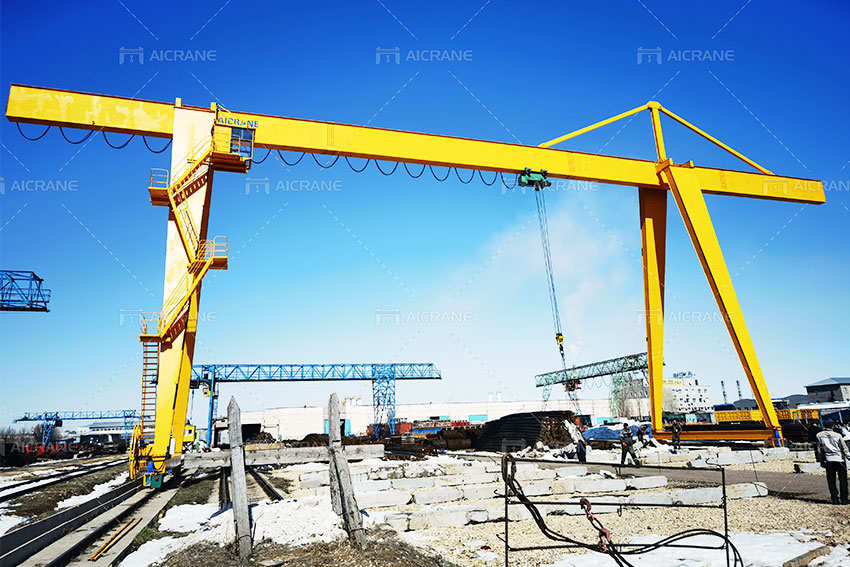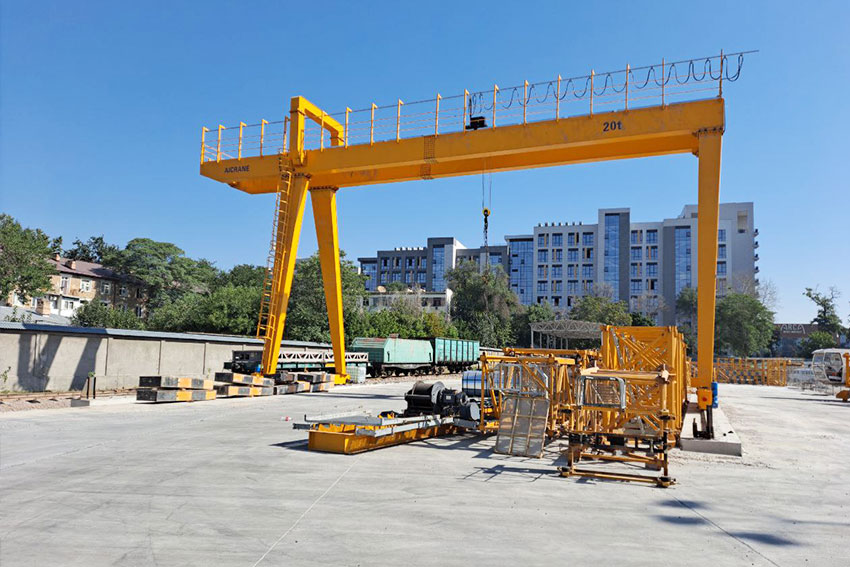Gantry cranes are widely used in various industrial applications due to their versatility, strength, and ability to perform heavy lifting tasks. A 20-ton gantry crane, which has a lifting capacity of 20 tons, is a common type of gantry crane used in different industries such as construction, logistics, steel production, and shipbuilding. One of the essential aspects of a 20-ton gantry crane is its gantry structure, which forms the base of the entire system and plays a crucial role in ensuring safe and efficient operations.
In this article, we will explore the different gantry structures that are used in a 20 ton gantry crane. We will look into the types of gantry frames, their design features, materials, and how they impact the crane’s performance. Additionally, we will highlight the importance of choosing the right gantry structure to match the specific lifting requirements.
What is a Gantry Crane?
A gantry crane is a type of overhead crane that moves along tracks or rails and is supported by gantry legs. The gantry structure provides the necessary support for the crane’s load-bearing capacity, making it ideal for lifting heavy loads. The structure consists of two primary components: the bridge (which spans the gap) and the gantry legs (which support the bridge and allow it to move along rails).
A 20-ton gantry crane is typically designed to lift weights up to 20 tons, which makes it suitable for applications that involve heavy lifting. The gantry frame structure plays a key role in supporting the crane’s movement and load-bearing capacity, ensuring the crane operates safely and efficiently.
Types of Gantry Structures in a 20-Ton Gantry Crane
The gantry structure of a 20-ton gantry crane can be classified into different types based on the design of the legs, the bridge, and the overall configuration. The main types of gantry structures found in these cranes are:
-
Single Girder Gantry Crane
-
Double Girder Gantry Crane
-
Truss Gantry Crane
-
Semi-Gantry Crane
Each of these structures has its own set of advantages and is chosen based on specific requirements such as the available space, load capacity, and type of lifting task. Let’s take a closer look at each of these gantry structures.
1. Single Girder Gantry Crane
A single girder gantry crane is one of the most common types of gantry cranes used for lighter lifting tasks, including the 20-ton capacity cranes. This structure is characterized by a single beam that spans the length of the crane and is supported by two gantry legs. The single girder gantry crane offers several benefits:
-
Cost-Effective: Since there is only one girder, the crane is relatively cheaper to manufacture and install.
-
Lightweight: The single girder design results in a less heavy crane, which makes it suitable for lighter lifting tasks and places less strain on the supporting structure.
-
Simple Design: The design is straightforward and less complex, making it easier to maintain and repair.
In a 20-ton gantry crane, the single girder design is often chosen when the load capacity requirement is moderate and the available space for the crane is limited. However, for extremely heavy loads or large spans, a double girder crane may be more suitable.

2. Double Girder Gantry Crane
The double girder gantry crane is the most robust type of crane structure, especially when dealing with high-load capacities like a 20-ton crane. As the name suggests, this crane has two parallel beams (or girders) running the length of the crane, providing greater strength and stability. The main features of the double girder gantry crane are:
-
Increased Load Capacity: The dual girder system provides better support for heavier loads, which enhances the crane’s lifting capabilities.
-
Improved Stability: The design offers more stability, making it ideal for high-lifting applications.
-
Larger Spans: Double girder cranes can cover larger spans, providing better operational flexibility.
-
More Control: These cranes typically offer more precise lifting and greater control due to the added support from the additional girder.
For a 20-ton double girder gantry crane, the double girder configuration is often chosen for its ability to handle heavier and more complex lifting operations. This type of structure is especially beneficial for industries that require high lifting capacities over large distances.

3. Truss Gantry Crane
A truss gantry crane is another option for heavy lifting tasks, often chosen for large-scale industrial operations. Unlike the solid girder structure, the truss structure incorporates a series of interconnected beams, forming a triangular pattern that enhances the crane’s strength. The main advantages of truss gantry cranes are:
-
Lightweight Design: The truss structure is lighter than solid girders while still maintaining a high degree of strength and stability.
-
High Wind Resistance: The truss structure is designed to withstand high wind conditions, making it suitable for outdoor environments such as shipyards and ports.
-
Longer Span Capabilities: Truss gantry cranes can span larger distances compared to solid girders, which makes them ideal for applications requiring long reach.
In a 20-ton gantry crane, the truss design is ideal when weight reduction is necessary, but the crane must still handle significant loads over large spans.
4. Semi-Gantry Crane
A semi-gantry crane is a hybrid design that combines elements of both gantry cranes and overhead cranes. In this structure, only one side of the crane is supported by gantry legs while the other side is supported by a fixed structure such as a building’s overhead rail. This design has the following characteristics:
-
Space-Efficient: The semi-gantry crane design makes it ideal for use in spaces where the crane can be supported on one side by an existing structure.
-
Lower Cost: Since only one side needs to be supported by gantry legs, the overall cost of construction is reduced.
-
Flexibility: Semi-gantry cranes are often used in applications where one side of the crane can be easily supported by a building, such as in workshops or warehouses.
While the semi gantry crane may not be as robust as the full gantry crane options, it provides a practical solution for 20-ton lifting operations where the load does not require a full gantry system.
Material Selection for Gantry Structures
The materials used in the construction of the gantry structure are crucial for ensuring the strength and durability of the crane. The materials must be strong enough to support heavy loads while also being resistant to wear and environmental conditions. Common materials used for gantry crane structures include:
-
Steel: Steel is the most widely used material due to its high strength-to-weight ratio. Carbon steel or alloy steel is commonly used for both the gantry frame and girder components.
-
Aluminum: In cases where weight is a critical factor, such as in portable cranes or smaller operations, aluminum can be used for lighter cranes.
-
Concrete: In some cases, reinforced concrete can be used for parts of the gantry structure, especially in permanent installations.
Factors to Consider When Choosing Gantry Structures
When selecting the appropriate gantry structure for a 20-ton crane, several factors must be taken into account:
-
Load Capacity: The crane’s load capacity is the primary factor in determining the gantry structure. If the load is significantly heavy, a double girder or truss gantry crane may be more suitable.
-
Available Space: The physical space where the crane will operate plays a significant role in the choice of gantry structure. In confined areas, a semi-gantry crane might be the best choice.
-
Environmental Conditions: If the crane is to be used outdoors or in harsh environments, a truss gantry crane’s wind resistance and strength may be necessary.
-
Span Requirements: For lifting applications that require longer spans, a double girder or truss gantry crane may be more appropriate due to their ability to cover greater distances.
Conclusion
The gantry structure of a 20-ton gantry crane is a critical component in determining the crane’s performance and suitability for specific tasks. Different types of gantry structures, such as single girder, double girder, truss, and semi-gantry cranes, offer varying levels of strength, stability, and flexibility. When choosing the right structure for a 20-ton gantry crane, it is essential to consider factors such as load capacity, span requirements, and the operational environment.
Each type of gantry structure has its unique advantages, and selecting the right one depends on the specific lifting requirements of the industry or application. By understanding the different gantry structures, businesses can make informed decisions that enhance the safety, efficiency, and reliability of their crane operations.
